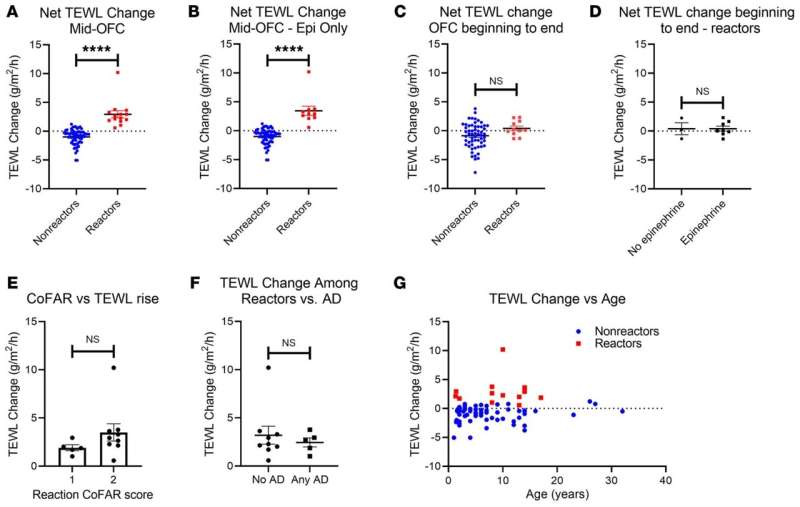This article has been reviewed according to Science X's editorial process and policies. Editors have highlighted the following attributes while ensuring the content's credibility:
fact-checked
peer-reviewed publication
trusted source
proofread
Measuring skin water loss found to predict anaphylaxis during food allergy tests

Food allergies can quickly turn a casual meal into a life-threatening situation. Anaphylaxis—a severe allergic reaction that may include a skin rash, nausea, vomiting, difficulty breathing, and shock—from a food allergy sends 200,000 people to the emergency room annually in the United States.
Because pinpointing a food allergy could mean life or death, an accurate diagnosis is critical.
Oral food challenges—when a patient ingests increasing doses up to a full serving of the suspected food allergen under supervision of a medical provider—are the diagnostic standard as skin and blood allergy tests have high false positive rates.
Although a highly accurate diagnostic test, patients often experience anaphylaxis during oral food challenges necessitating an epinephrine injection.
A team of University of Michigan researchers developed a method that measures water loss from the skin to predict anaphylaxis during oral food challenges before it becomes clinically evident.
The results are published in The Journal of Clinical Investigation.
"This method could enhance the ability to detect and predict anaphylaxis during oral food challenges prior to the need for epinephrine, greatly improving patient safety and comfort," said Charles Schuler, M.D., lead author of the study and an immunologist at Michigan Medicine.
Building on existing research
During anaphylaxis, the dilation or widening of the blood vessels increases heat and water loss from the surface of the skin.
Previous research has assessed facial thermography, which uses a specialized camera to detect heat patterns emitted from the skin, as a method to predict anaphylaxis.
However, this method requires optics expertise, tightly controlled conditions and for the patient to sit still for an extended period—making this an impractical choice, especially for assessing food allergies in children.
The researchers validated the use of transepidermal water loss, a measurement that represents the amount of water that escapes from a given skin area per hour, by comparing its ability to detect anaphylaxis with biochemical and clinical observation methods.
They found that transepidermal water loss increases during food allergy reactions and anaphylaxis.
The rise in skin water loss correlated with biochemical markers of anaphylaxis and substantially preceded clinical detection of anaphylaxis.
"Transepidermal water loss measurement can be done in office without specialized equipment, affixed to the skin and works in children making it a vast improvement from previous attempts at early anaphylaxis detection methods," said Schuler.
Schuler's research group is currently recruiting participants aged 6 months to 5 years old for a pilot clinical trial, Predicting Peanut Anaphylaxis and Reducing Epinephrine, that monitors transepidermal water loss from the forearm during a peanut allergy food challenge.
Results will help pinpoint values associated with anaphylaxis to determine "stopping rules" to end oral food challenges, hopefully reducing the need for epinephrine injections.
More information: Charles F. Schuler et al, Transepidermal water loss rises before food anaphylaxis and predicts food challenge outcomes, Journal of Clinical Investigation (2023). DOI: 10.1172/JCI168965


















